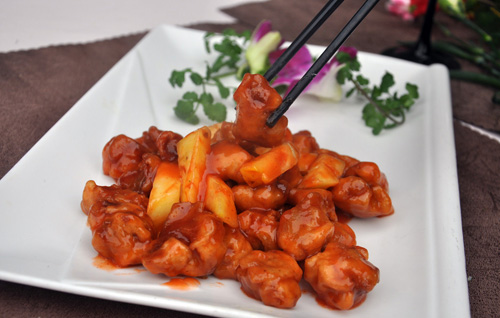
They include xiaolongbao (steamed dumpling filled with minced pork and stock), jiaozi (饺子 boiled dumpling with meat filling), mixed noodle and hai zhe tou (海蜇头 tossed jelly fish).
"Vinegar is a versatile enhancer," says Dicky To, executive Chinese chef at The Peninsula Shanghai where he uses vinegar in summer appetizers.
In addition to intensifying flavor, vinegar can develop the delicate and sweet flavor in shellfish, cut the oil and grease in pork dishes, cover the earthy, fishy taste of river fish, and stimulate digestion when people eat too much.
Taste of first love
Chinese vinegar and sugar create the sweet and sour taste familiar to many Westerners whose first taste of Chinese food may be gu lao rou (咕咾肉), sweet-and-sour pork stir-fried with pineapple.

Chinese describe sweet and sour as "the taste of first love."
The tip of the tongue tastes sweetness, the sides taste sourness and the back tastes bitterness.
"We perceive the flavor in the tip, then the sides and the back so the sweet-and-sour taste connects seamlessly," chef To explains.
Both tang cu (糖醋 braising with vinegar and sugar) and gu lao (咕咾 stir-frying in sweet and sour sauce) are popular ways of cooking with vinegar and sugar.
Tang cu paigu (糖醋排骨) is pork rib deep-fried and braised with soy sauce, aged vinegar and sugar.
The pork, after being tenderized by the acid in vinegar and then deep-fried, is crisp outside and juicy inside. Soy sauce adds more roundness to the rich dish that has a balance of sweet and sour taste.
We recommend:
